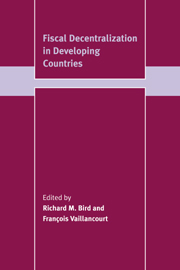Book contents
- Frontmatter
- Contents
- List of tables
- List of contributors
- Preface
- 1 Fiscal decentralization in developing countries: an overview
- 2 China: evaluating the impact of intergovernmental fiscal reform
- 3 India: intergovernmental fiscal relations in a planned economy
- 4 Indonesia and Pakistan: fiscal decentralization – an elusive goal?
- 5 Morocco and Tunisia: financing local governments – the impact on infrastructure finance
- 6 Colombia: the central role of the central government in fiscal decentralization
- 7 Argentina: fiscal federalism and decentralization
- 8 South Africa: an intergovernmental fiscal system in transition
- 9 Bosnia-Herzegovina: fiscal federalism – the Dayton challenge
- Index
9 - Bosnia-Herzegovina: fiscal federalism – the Dayton challenge
Published online by Cambridge University Press: 09 October 2009
- Frontmatter
- Contents
- List of tables
- List of contributors
- Preface
- 1 Fiscal decentralization in developing countries: an overview
- 2 China: evaluating the impact of intergovernmental fiscal reform
- 3 India: intergovernmental fiscal relations in a planned economy
- 4 Indonesia and Pakistan: fiscal decentralization – an elusive goal?
- 5 Morocco and Tunisia: financing local governments – the impact on infrastructure finance
- 6 Colombia: the central role of the central government in fiscal decentralization
- 7 Argentina: fiscal federalism and decentralization
- 8 South Africa: an intergovernmental fiscal system in transition
- 9 Bosnia-Herzegovina: fiscal federalism – the Dayton challenge
- Index
Summary
The challenge of fiscal federalism in Bosnia is perhaps unique in the world: the Dayton talks held in October 1995, immediately after the ceasefire, began with a fully blank slate.
How would the new nation that emerged as a result of the peace talks be structured from a fiscal perspective?
What would be the role of the central state and what would be that of the two subnational units (the “entities”) that constituted it?
How would the three previously warring communities of Croats, Bosnian Muslims (Bosniacs), and Serbs work together to form a central government, what would the entity governments look like, and what would be the fiscal functions and rights of these entities?
How would the entities, in turn, be structured internally, and what would be their fiscal governance?
All these questions were open in October 1995, when the international community worked together with experts and political leaders to forge, for Bosnia, a new constitution, and the new intergovernmental fiscal system that would be set out in it. The new system of fiscal federalism should, it was agreed, be able to withstand the stresses that would be a natural consequence of the centrifugal forces still present in the country, be economically sensible, and yet also obtain the consensus of the three parties who would live with it and implement it. The purpose of this chapter is to describe Bosnia's current arrangements in fiscal federalism, to outline the unique challenges that the Dayton system proposed, and to draw some lessons for the design of fiscal federal systems in ethnically diverse economies.
- Type
- Chapter
- Information
- Fiscal Decentralization in Developing Countries , pp. 271 - 300Publisher: Cambridge University PressPrint publication year: 1999
- 1
- Cited by



